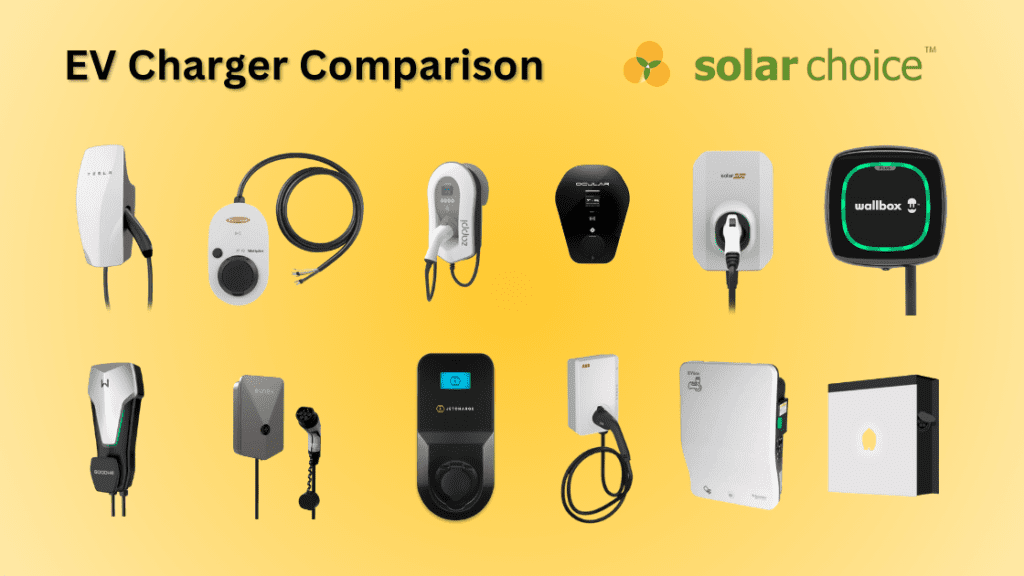Compare EV Charger quotes from trusted installers
Compare EV Charger Reviews Available in Australia
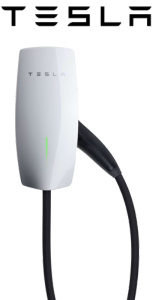
Tesla
EV Charger
Office in Australia:
Yes
Made In:
USA
Solar Choice Score:
Warranty:
4 years
Approximate Retail Price:
$750
Open Charge Point Protocol (OCPP):
No
Solar System Integration:
No
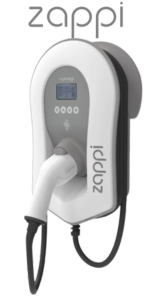
Zappi
EV Charger
Office in Australia:
Yes
Made In:
United Kingdom
Solar Choice Score:
Warranty:
3 years
Approximate Retail Price:
From $1,200
Open Charge Point Protocol (OCPP):
Yes
Solar System Integration:
Yes
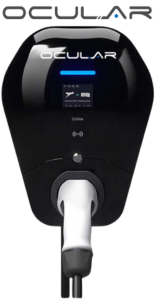
Ocular
EV Charger
Office in Australia:
Yes
Made In:
China
Solar Choice Score:
Warranty:
2 years
Approximate Retail Price:
From $1,200
Open Charge Point Protocol (OCPP):
Yes
Solar System Integration:
Yes
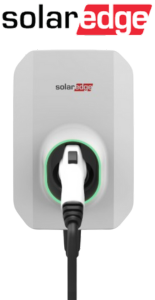
SolarEdge
EV Charger
Office in Australia:
Yes
Made In:
China
Solar Choice Score:
Warranty:
5 years
Approximate Retail Price:
From $1,850
Open Charge Point Protocol (OCPP):
No
Solar System Integration:
Yes with SolarEdge inverter

Evnex
EV Charger
Office in Australia:
No
Made In:
New Zealand
Solar Choice Score:
Warranty:
3 years
Approximate Retail Price:
From $1,268
Open Charge Point Protocol (OCPP):
Yes
Solar System Integration:
Yes via included CT

Fronius
EV Charger
Office in Australia:
Yes
Made In:
Austria
Solar Choice Score:
Warranty:
2 years
Approximate Retail Price:
From $1,900
Open Charge Point Protocol (OCPP):
Yes
Solar System Integration:
Yes requires Fronius Smart Meter

Wallbox Pulsar
EV Charger
Office in Australia:
No
Made In:
China
Solar Choice Score:
Warranty:
3 years
Approximate Retail Price:
From $1,500
Open Charge Point Protocol (OCPP):
Yes
Solar System Integration:
Yes

ABB
EV Charger
Office in Australia:
Yes
Made In:
China
Solar Choice Score:
Warranty:
2 years
Approximate Retail Price:
From $1,950
Open Charge Point Protocol (OCPP):
Yes
Solar System Integration:
Yes
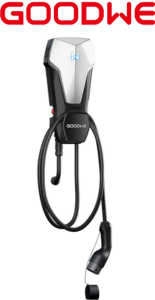
GoodWe
EV Charger
Office in Australia:
Yes
Made In:
China
Solar Choice Score:
Warranty:
2 years
Approximate Retail Price:
From $800
Open Charge Point Protocol (OCPP):
No
Solar System Integration:
Yes, with additional hardware

Autel
EV Charger
Office in Australia:
Yes
Made In:
China
Solar Choice Score:
Warranty:
3 years
Approximate Retail Price:
From $800
Open Charge Point Protocol (OCPP):
Yes
Solar System Integration:
No
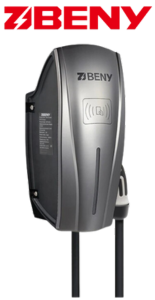
ZJ Beny
EV Charger
Office in Australia:
No
Made In:
China
Solar Choice Score:
Warranty:
3 years
Approximate Retail Price:
From $975
Open Charge Point Protocol (OCPP):
Yes
Solar System Integration:
Yes with additional hardware
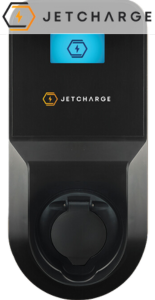
JET Charge
EV Charger
Office in Australia:
Yes
Made In:
Australia
Solar Choice Score:
Warranty:
3 years
Approximate Retail Price:
From $1,650
Open Charge Point Protocol (OCPP):
Yes
Solar System Integration:
Yes
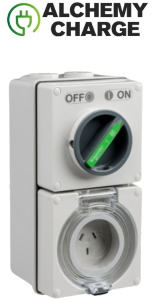
Alchemy Charge
EV Charger
Office in Australia:
Yes
Made In:
Australia
Solar Choice Score:
Warranty:
Lifetime, if remain subscribed years
Approximate Retail Price:
$299
Open Charge Point Protocol (OCPP):
No
Solar System Integration:
No
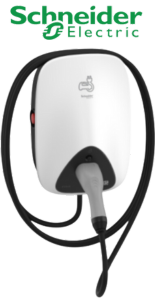
Schneider
EV Charger
Office in Australia:
Yes
Made In:
China
Solar Choice Score:
Warranty:
2 years
Approximate Retail Price:
From $1,350
Open Charge Point Protocol (OCPP):
Yes
Solar System Integration:
Yes

FIMER
EV Charger
Office in Australia:
Yes
Made In:
Italy
Solar Choice Score:
Warranty:
2 years
Approximate Retail Price:
From $1,949
Open Charge Point Protocol (OCPP):
Yes
Solar System Integration:
Yes
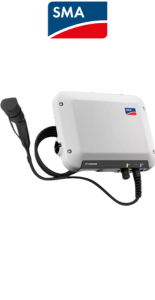
SMA
EV Charger
Office in Australia:
Yes
Made In:
Germany
Solar Choice Score:
Warranty:
5 years
Approximate Retail Price:
$2,500
Open Charge Point Protocol (OCPP):
No
Solar System Integration:
Yes with SMA inverter
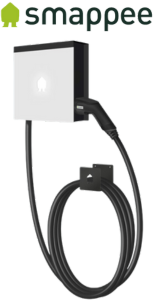
Smappee
EV Charger
Office in Australia:
No
Made In:
Belgium
Solar Choice Score:
Warranty:
2 years
Approximate Retail Price:
From $1,500
Open Charge Point Protocol (OCPP):
Yes
Solar System Integration:
Yes
What Makes a Good EV Charger in Australia? 2025 Solar Choice Criteria
The 2025 Solar Choice EV Charger Scorecard is an independent evaluation system that helps homeowners make confident decisions based on what truly matters: value, support, compatibility, and user-friendly features.
1. Price: Understanding Value Beyond Cost
EV charger pricing varies significantly depending on brand, smart features, and solar integration capabilities.
Scoring tiers:
- $$$$$ – Over $2,500
- $$$$ – $2,000 to $2,500
- $$$ – $1,500 to $2,000
- $$ – $1,000 to $1,500
- $ – Under $1,000
Higher scores are awarded to lower-priced products, but only when balanced with functionality and reliability.
2. Company Trust and Local Presence
Solar Choice scores each brand on factors that reflect long-term support and company stability:
- Physical office in Australia (2 points)
- Over 20 local staff (1 point)
- 5+ years in business (1 point)
- Diversified product offering (1 point)
A higher trust score indicates a well-established, reliable provider.
3. Warranty Quality and Terms
The warranty reflects product confidence and post-sale support:
- Typically ranges from 2 to 5 years
- 1 point per year of warranty
- Brands with clearly worded, customer-friendly terms score higher
4. Solar Integration Capabilities
To maximise savings and renewable use, EV chargers should integrate well with solar setups. You can learn more about best practices from the Clean Energy Council’s guidelines for solar-compatible systems:
- 2 points: Direct solar charging support (e.g., automatic surplus detection)
- 1 point: CT clamp or inverter compatibility
The better the integration, the higher the score.
5. Functionality and Smart Features
Today’s chargers go beyond plug-and-play. Key features earn points:
- OCPP support for third-party platforms
- LCD display for local control
- Dynamic load management (DLM)
- IP55+ rating for weatherproofing
- Cable length options (6m+)
More features mean more adaptability and control for the homeowner.
Making the Most of the Solar Choice EV Charger Scorecard
To get the best value from your EV charger investment, it’s important to look beyond headline specs and price tags. The Solar Choice EV Charger Scorecard offers a transparent, third-party comparison, but it’s most effective when used in conjunction with your personal needs and research.
Cross-Check Sources
Use this scorecard as a foundational guide, but validate with:
- Installer recommendations tailored to your home setup
- Manufacturer documentation on features and integration
- Independent customer reviews and user forums
Know Your Priorities
Different homes have different charging needs. Ask yourself:
- Do I want to charge mainly from solar power?
- Is app control and usage tracking important?
- Will I need to manage energy across multiple devices?
- What’s my budget ceiling, and am I future-proofing?
Confirm Details Before Purchase
Technology is evolving quickly. Always check:
- Product specs and firmware updates
- Installation compatibility and cable length
- Warranty coverage and support terms
- Local rebates or government incentives
The scorecard helps you cut through marketing and make side-by-side comparisons, but your ideal EV charger should reflect your home’s solar capacity, energy habits, and budget.
Home EV Charger installation considerations
Each home is different, but here are some of the factors that will change the price:
- The distance from your main switchboard to the EV charger location. Due to the high electrical demand of an EV Charger, your electrician will need to pull a new circuit from the main switchboard with its own breaker. The length and difficulty of this cable run will impact some of your costs.
- 3-phase or 1-phase EV charger. Three-phase charging solutions require bigger cables and can require additional work at your switchboard to enable the new circuit.
- Outdoor and ground-mounted EV Chargers. If you want your charger to be mounted on your driveway, then you are looking at a more expensive install to cover the trenching, pole-mounting and weatherproofing the EV charging solution.
But how much does it cost to actually charge your EV? The cost of charging an electric vehicle depends on factors like electricity rates, battery capacity, and charging speed. Read our guide on how much it costs to charge an EV to understand the ongoing costs associated with home and public charging.
Ready to get an EV charger installation quote?
Compare quotes for an EV chargers from pre-vetted installers near you
Take charge with your new EV
What if I live in an apartment?
Can I save on EV Charging Costs with solar?
By leveraging solar energy, EV owners can significantly reduce their charging costs. For a comprehensive breakdown of EV charging expenses and potential savings, read our guide on how much it costs to charge an EV in Australia.
- Why a big battery could be cheaper than a small battery with the federal rebate? - 19 June, 2025
- Heat Pump Costs – Solar Choice Price Index - 1 June, 2025
- Solar Panel Costs: Solar Choice Price Index | July 2025 - 1 June, 2025
